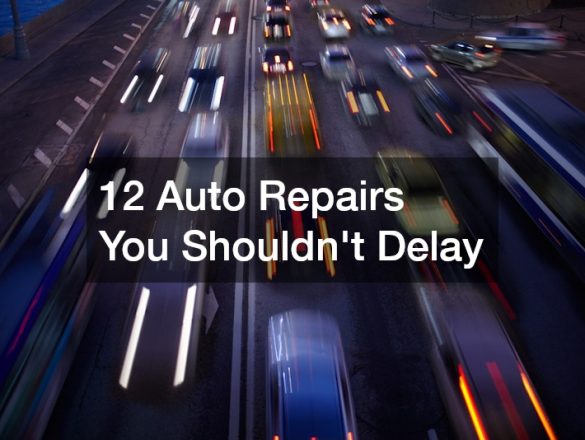
Keeping your vehicle in prime condition is about more than just ensuring it looks good. Timely maintenance and prompt attention to emerging problems can be the difference between a safe, dependable ride and costly, time-consuming repairs down the road. Whether you’re a daily commuter trying to get to work without trouble, a family hauling groceries and kids, or someone who depends on your vehicle for business, staying on top of repairs can save you both money and stress. Minor issues that are ignored now could lead to major breakdowns later—or worse yet, create safety hazards on the road.
Many people put off seemingly small fixes because they have busy schedules or are worried about the price tag. However, postponing even routine services can jeopardize vehicle performance and significantly impact overall lifespan. The best approach is to be proactive: listen for unusual sounds, watch for warning lights, and note any changes in how the car handles. A local auto repair shop can advise on how urgent each repair is and guide you toward the right solutions for your vehicle.
In some cases, you might experience an obvious problem, like a cracked windshield that calls for immediate auto glass repair. In other instances, the warning signs can be more subtle—perhaps your transmission shifts feel “off” or your brakes emit a faint squeak. Paying attention to these cues can alert you to issues before they become dangerous or require more expensive intervention. A delay might also result in compounding damage. For instance, a small misalignment can rapidly wear out tires, or a slipping transmission could lead to a complete system failure.
Whether you drive a compact sedan, a family SUV, or a commercial vehicle, routine upkeep is crucial. This includes everything from engine repairs to specialized services like local van repair or even detroit diesel truck repairs, depending on your needs. In addition, if your vehicle has cosmetic or body-related concerns—such as dents, scrapes, or chipped paint—those, too, can escalate if neglected for too long.
Below, we’ll dive into 12 specific auto repairs you should never delay. Each item explains what can happen if you wait, how to spot the early warning signs, and why timely intervention is so essential. By staying informed and taking preventative measures, you’ll help your vehicle run better, last longer, and keep you safer whenever you hit the road.
1. Strange Engine Noises
Your engine is the heart of your vehicle, so it’s vital to address any odd sounds as soon as they occur. A knocking noise, for instance, may suggest issues with the combustion process or worn components that might be on the brink of failure. Squealing or squeaking might point to a problem with belts, pulleys, or tensioners. Even subtle clicks or ticks can be the early signs of deeper mechanical trouble.
Delaying diagnosis could turn a minor issue into a full-blown crisis. For example, a worn timing belt could snap if it isn’t replaced in time, causing internal damage. Problems with valves or spark plugs may evolve into broader engine failures, increasing both the complexity and cost of engine repairs. Paying attention to unexpected sounds is an excellent way to detect potential problems before they become catastrophes.
You don’t have to be a mechanic to suspect something’s amiss under the hood. When you notice a sound that doesn’t feel normal or that you’ve never heard before, your best step is to schedule an inspection. A trusted local auto repair shop can quickly identify the cause and provide an effective solution. They’ll also help you with preventive maintenance, such as fluid checks and regular part replacements, which can stave off pricey repairs later.
Even if you drive a commercial fleet vehicle and require specialized services like detroit diesel truck repairs, the principle remains the same: unusual noises signal trouble. Rather than waiting to see if it “goes away,” be proactive and have an expert evaluate your engine. Doing so will help ensure reliability and can save you from facing unexpected breakdowns on the road.
2. Post-Collision Body Damage

Accidents can happen to even the most cautious drivers, and the resulting damage might seem merely cosmetic at first glance. You may have some dents, scrapes, or bent panels that you’re tempted to leave alone, especially if the car still drives fine. However, postponing a visit to an auto collision shop is never a good idea. Even small dents can compromise your vehicle’s structural integrity or hide deeper issues underneath the surface.
Body damage can lead to exposed metal, which is vulnerable to rust and corrosion, especially if you frequently drive in areas with rain, snow, or salted roads. Over time, rust can eat away at critical components and spread beyond the initial impact site. Furthermore, alignment issues might arise if the impact has shifted the frame. These alignment issues can cause uneven tire wear and steering problems, endangering both your safety and your wallet.
Delaying repairs also risks missing out on essential bumper repair services. Your bumper is designed to absorb impact and protect you and your passengers during collisions. A compromised bumper might not function correctly if you’re involved in another accident. Many modern vehicles also have sensors and cameras integrated into body panels, and any misalignment can cause malfunction or inaccurate readings.
If you notice that your doors don’t close properly or your trunk alignment is off, it’s time to act. A thorough inspection by professionals can determine if there’s structural damage that demands immediate attention. In some cases, automotive coating work might be necessary to protect repaired panels and keep them looking new. Addressing post-collision body damage promptly helps maintain the look, safety, and value of your vehicle, ensuring it can continue to serve you well for years to come.
3. Brake Issues
Brakes are arguably the most critical safety feature in your vehicle. They allow you to control your speed and bring the car to a stop when faced with hazards. If you notice squeaking, grinding, or vibrations when applying the brakes, it’s an immediate red flag that something might be wearing down or malfunctioning. Soft or spongy brake pedal feel can also indicate a problem, possibly involving brake fluid or the master cylinder.
Many drivers make the mistake of underestimating early warning signs. They’ll assume that slight squealing is just dust or minor buildup. While it could be something as simple as dirt accumulation, it can also be the first indication of worn brake pads. Delaying replacement could lead to metal-on-metal contact, severely damaging the rotors and resulting in a far more expensive fix.
Beyond the pads and rotors, your brake lines, calipers, and other components require periodic checks to ensure everything is in working order. If you frequently tow or carry heavy loads—like when you rely on local van repair for work vans—your brakes can face extra stress. Regular inspections are crucial under these conditions because the heavier the load, the more pressure put on the brake system.
4. Transmission Problems
The transmission is second only to the engine in terms of crucial vehicle components. It transfers power from the engine to the wheels, allowing you to shift gears smoothly and maintain control over acceleration. A malfunctioning transmission might manifest as delayed shifting, slipping gears, or grinding noises. You may also notice a burnt smell if fluid is overheated or leaking.
Because transmission work can be costly, some drivers are tempted to postpone it, hoping the symptoms will fade. However, ignoring these red flags often leads to more extensive damage and, ultimately, an even higher repair bill. In severe cases, a complete rebuild or replacement might be necessary. If you’re experiencing unusual shifting or suspect a leak, consulting an automatic transmission shop is your best move to avoid exacerbating the problem.
Proactive fluid changes can extend the life of your transmission significantly. Transmission fluid is designed to lubricate and cool the internal gears, bands, and other components. Over time, this fluid can break down, become contaminated with metal shavings, or leak through worn seals. With routine checks, you can keep your transmission functioning at its best.
5. Overheating and Cooling System Failures

Your vehicle’s cooling system keeps the engine at the optimal operating temperature, preventing parts from warping or melting under extreme heat. When the temperature gauge climbs into the red or you see steam billowing from under the hood, you’re likely dealing with an overheating issue. If you continue to drive in this condition, severe engine damage can occur, escalating the repair costs significantly.
Common culprits include a faulty thermostat, a leaking radiator, worn hoses, or a malfunctioning water pump. In some cases, the fan designed to draw in cool air stops working correctly. If your cooling system fails, you may need partial or even major engine repairs, which can become expensive and time-consuming.
If you do notice the temperature gauge rising or the check engine light illuminating, pull over safely and turn off the vehicle. Continuing to drive can exacerbate the damage, and modern engines are not as tolerant of high temperatures as older models. Once you can safely do so, contact a local auto repair shop for advice. They might recommend checking the coolant level or towing your vehicle if the problem seems severe.
Preventive measures go a long way. Routine checks of coolant levels, flushing the system according to manufacturer guidelines, and keeping an eye out for unusual smells or damp spots under the hood can help you spot small leaks early. Addressing these issues as soon as they appear is not just about cost savings; it’s also crucial for preserving performance and safety.
6. Electrical System Malfunctions
Modern vehicles rely heavily on electronic systems for everything from ignition and lighting to advanced infotainment and safety features. When your car struggles to start, your headlights dim unexpectedly, or your dashboard warning lights flicker, these can be indications of an electrical malfunction. Issues might stem from a failing alternator, a bad battery, corroded cables, or even blown fuses.
While some drivers might ignore minor glitches—like a dash light flickering occasionally—these early signals can point to bigger underlying problems. For instance, an undercharged battery or a malfunctioning alternator can leave you stranded unexpectedly. If your engine won’t turn over at all, you could require both engine repairs (if there’s mechanical overlap) and electrical troubleshooting.
Another element of your electrical system is the computer controlling various sensors that detect critical functions like air-fuel mixtures, engine timing, and emissions control. A glitch in this system might cause erratic performance or reduced fuel efficiency. In extreme cases, an electrical short can spark a fire or damage crucial components, rendering your vehicle undrivable.
7. Minor Body Dents and Scratches

It’s easy to dismiss small dents or surface scratches as mere cosmetic concerns. However, these minor imperfections can develop into more significant issues if left unattended. Dents can cause weakening of the metal body panels, making them vulnerable to further damage or rust formation. Scratched paint, on the other hand, exposes the underlying metal or primer, allowing moisture, salt, and chemicals to corrode the surface.
Over time, that small scratch may turn into a patch of rust that spreads beyond the initial area, jeopardizing the structural integrity of your vehicle. If you also factor in automotive coating benefits, which help protect the exterior from UV damage and corrosion, it becomes clear why prompt attention is essential. Even a tiny exposed spot can lead to deterioration across a broader surface.
You might think you can handle the damage yourself with touch-up paint, but professional assessment at an auto collision shop can reveal whether there are hidden risks. For instance, the impact that caused the dent might have misaligned internal components or wiring, especially if it occurred near a sensor or camera. Additionally, professional bumper repair services can correct underlying issues beyond just repainting or reshaping.
8. Windshield and Window Damage
A cracked or chipped windshield may seem like a minor annoyance, but it can quickly escalate if not addressed. Changes in temperature, impacts from road debris, and the stress of everyday driving can cause a small crack to spread across the entire windshield. Once the damage is too extensive, the only option is a full replacement, which can be significantly more expensive than an initial auto glass repair.
A compromised windshield also presents a safety hazard. Modern windshields are engineered to provide structural support to the vehicle, especially in rollover accidents. They can also help airbag systems deploy correctly. A weakened windshield may fail to serve these essential functions, putting you and your passengers at risk. Additionally, chips or cracks within your line of sight can obstruct your view, reducing reaction times and increasing the likelihood of an accident.
Side windows and rear windows also deserve prompt attention if they show signs of cracking or other issues. If you’ve invested in auto glass tinting, damaged windows might require specialized repair or reapplication of the tint. Plus, shattered glass from a neglected crack can create additional danger if it breaks spontaneously.
9. Tire and Wheel Problems
Your tires are the only points of contact between your car and the road, making their condition extremely important. Worn tread, uneven wear, bulges in the sidewall, or slow leaks can all compromise your vehicle’s safety. Delaying new tires or rotation services can reduce traction, increase stopping distances, and heighten the risk of blowouts.
Similarly, wheel alignment issues can create uneven wear patterns on your tires, leading you to replace them more frequently. Poor alignment can also make it more difficult to steer or maintain control in wet or icy conditions. Vibrations in the steering wheel or the seat might be a clue that your wheels are out of balance or that your suspension is malfunctioning.
If you drive a heavier vehicle, such as a commercial van, you might already be familiar with the need for consistent maintenance and local van repair services. Tire upkeep is just as important in these vehicles because of their heavier weight distribution and the demands placed on the suspension and steering systems.
10. Exhaust System Problems
A healthy exhaust system is vital for both your vehicle’s performance and environmental compliance. When your exhaust system starts to fail, you might hear louder-than-normal engine noise, detect the smell of fumes inside the car, or notice reduced fuel efficiency. While some drivers might tune out the louder growl, continuing to drive without addressing these issues can cause more extensive damage.
Leaking exhaust gases can pose serious health risks if they infiltrate the cabin. Carbon monoxide, in particular, is colorless and odorless, making it extremely dangerous. If you suspect an exhaust leak, you should address it immediately to safeguard the well-being of everyone in the vehicle. Additionally, small leaks can become large ones quickly, accelerating corrosion on components like the muffler, catalytic converter, and exhaust pipes.
Aside from safety concerns, a failing exhaust system can also trigger the check engine light, especially if the issue affects oxygen sensors or catalytic converter performance. In such cases, your engine’s control module might attempt to compensate by adjusting the air-fuel mixture, resulting in poor fuel economy or sluggish acceleration.
11. Timing Belt or Chain Replacement
Your timing belt or timing chain is a critical component that synchronizes the rotation of the crankshaft and camshaft(s) to ensure the engine’s valves open and close precisely. If this belt or chain fails, the pistons and valves can collide, causing catastrophic engine damage. In many engines, this results in extremely high repair bills and significant downtime.
Manufacturers typically recommend replacing the timing belt at specific intervals, often between 60,000 and 100,000 miles, though this varies. A chain often lasts longer, but it’s not immune to wear. Strange rattling noises, especially upon starting the engine, or a general sense of misfiring can indicate timing issues. Delaying this service can turn a relatively routine replacement into a major, costly overhaul.
When you take your vehicle in for scheduled maintenance, ask the technicians to inspect the timing belt or chain, along with related components like tensioners and water pumps. Replacing these parts preemptively can save you from an unexpected breakdown or from needing extensive engine repairs later. If you’ve purchased a used vehicle and you’re uncertain about the replacement history, consider having it checked immediately.
12. Fluid Leaks

Fluids are your vehicle’s lifeblood, serving various functions like lubrication, cooling, and power transfer. Common fluids include motor oil, transmission fluid, coolant, brake fluid, and power steering fluid. Spotting a puddle under your vehicle, whether it’s dark oil or bright-green coolant, should prompt immediate attention.
Small leaks might seem harmless, but they often indicate failing seals, cracked hoses, or other deteriorating components. Over time, these leaks worsen, risking engine failures, overheating, or dangerous brake malfunctions. For instance, if your transmission fluid is slowly leaking, your vehicle might begin to shift erratically, causing more extensive damage that will likely land you in an automatic transmission shop for a major rebuild.
Addressing fluid leaks is critical for preserving vehicle performance, protecting the environment, and ensuring safety. Whether you drive a compact car, an SUV, or need commercial services like detroit diesel truck repairs, fluid maintenance is one of the most basic yet vital aspects of automotive care.
Whether you require professional automotive coating to protect against weather and corrosion, or you need more specialized services such as Detroit diesel truck repairs, finding a reliable local auto repair shop is half the battle. Reputable technicians have the experience and tools to diagnose problems accurately, whether it’s dealing with a leaking brake line, a failing timing belt, or a complex electrical glitch.
Ultimately, the lesson here is simple: When it comes to vehicle maintenance, don’t wait. Address issues early, follow your manufacturer’s recommended service intervals, and pay attention to any signs that something isn’t right. By doing so, you’ll protect your investment, ensure a safer ride for everyone on board, and avoid the cascading effects that often result from delayed auto repairs.




